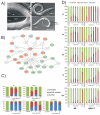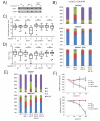DAF-16/FOXO and EGL-27/GATA promote developmental growth in response to persistent somatic DNA damage
- PMID: 25419847
- PMCID: PMC4250074
- DOI: 10.1038/ncb3071
DAF-16/FOXO and EGL-27/GATA promote developmental growth in response to persistent somatic DNA damage
Abstract
Genome maintenance defects cause complex disease phenotypes characterized by developmental failure, cancer susceptibility and premature ageing. It remains poorly understood how DNA damage responses function during organismal development and maintain tissue functionality when DNA damage accumulates with ageing. Here we show that the FOXO transcription factor DAF-16 is activated in response to DNA damage during development, whereas the DNA damage responsiveness of DAF-16 declines with ageing. We find that in contrast to its established role in mediating starvation arrest, DAF-16 alleviates DNA-damage-induced developmental arrest and even in the absence of DNA repair promotes developmental growth and enhances somatic tissue functionality. We demonstrate that the GATA transcription factor EGL-27 co-regulates DAF-16 target genes in response to DNA damage and together with DAF-16 promotes developmental growth. We propose that EGL-27/GATA activity specifies DAF-16-mediated DNA damage responses to enable developmental progression and to prolong tissue functioning when DNA damage persists.
Figures







References
-
- Schumacher B, Garinis GA, Hoeijmakers JHJ. Age to survive: DNA damage and aging. Trends Genet. 2008;24:77–85. - PubMed
-
- Cleaver JE, Lam ET, Revet I. Disorders of nucleotide excision repair: the genetic and molecular basis of heterogeneity. Nat Rev Genet. 2009;10:756–768. - PubMed
-
- Bartek J, Lukas J. DNA damage checkpoints: from initiation to recovery or adaptation. Curr. Opin. Cell Biol. 2007;19:238–245. - PubMed
Additional References
-
- Sakurai H, Enoki Y. Novel aspects of heat shock factors: DNA recognition, chromatin modulation and gene expression. FEBS J. 2010;277:4140–4149. - PubMed
Publication types
MeSH terms
Substances
Grants and funding
LinkOut - more resources
Full Text Sources
Other Literature Sources
Medical
Molecular Biology Databases
Miscellaneous

